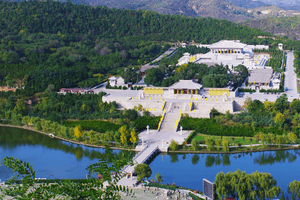Xuanyuan teaching
Xuanyuandao (軒轅道 "Way of Xuanyuan")[lower-alpha 1], also known as Xuanyuanism (軒轅教[lower-alpha 2]) or Huangdiism (黄帝教[lower-alpha 3]), is a Confucian folk religion of China which was founded in Taipei, Taiwan, in 1952.[1] The founder was Wang Hansheng (王寒生) (1899–1989), a legislator.[2] The Church of Xuanyuan aims to restore the "national religion" of archaic (pre-Han dynasty) China,[3] with Huangdi as the universal God.
| Church of Xuanyuan 軒轅教會 Xuānyuánjiàohuì | |
|---|---|
 | |
| Type | Confucian church |
| Classification | Chinese salvationist religion |
| Scripture | Four Books and Five Classics |
| Founder | Wang Hansheng |
| Origin | 1952 Taiwan |
| Other name(s) | Way of Xuanyuan (軒轅道), Huangdiism (黄帝教) |
| Official website | http://huangdi-culture.org/ |
| Part of a series on |
| Chinese folk religion |
|---|
 |
|
Theory
Model humanity: |
|
Institutions and temples |
|
Internal traditions Major cultural forms
Main philosophical traditions: Ritual traditions: Devotional traditions: Zhenkong, "Void of Truth". Confucian churches and sects:
|
|
Related religions
|
Theology and practices
The Church of Xuanyuan subsumes all the ways of worship to local deities under one national god, Xuanyuan Huangdi (軒轅黄帝 "Xuanyuan the Yellow Deity"[lower-alpha 4]). According to the Shiji, Xuanyuan was the name of Huangdi,[4] and he is traditionally considered the thearch (progenitor god) of the Han Chinese race.[5]
Xuanyuanism is based on Confucian rationalism, and therefore rejects practices it considers superstitious that are found in other sects of Chinese folk religion, such as scripture writing through god mediumship.[6]
Diffusion
As of 2013 the Xuanyuandao has 200,000 adherents in Taiwan and is active in China, where it runs temples, schools, and members take part in the sacrifices celebrated at the Xuanyuan Temple, the largest temple dedicated to Huangdi in the world.[7] Huangdi is also worshipped in Chinese folk religion by millions of people who do not necessarily belong to the Church of Xuanyuan.
Footnotes
- 軒轅道 Xuānyuándào, traditional characters: 軒轅道. Xuanyuan is said to have been the Yellow Emperor's personal name.
- 軒轅教 Xuānyuánjiào
- 黄帝教 Huángdìjiào, traditional characters: 黃帝教; "faith in the Yellow Deity"
- The color yellow [huáng 黄] represents earth, the dragon, and the centre of the universe [Shangdi] in Chinese cosmologies, and is used as a revelative character for the homophone huáng 皇 "august, generative".
References
- Goossaert, Palmer. 2011. p. 295
- Jochim 2003. p. 60
- Goossaert, Palmer. 2011. p. 295
- Clart, Jones. 2003. p. 60
- Clart, Jones. 2003. p. 60
- Journal of Chinese Religions, 1997, n. 25. p. 18
- Baidu Baike Encyclopedia: 轩辕教.
Sources
- Christian Jochim, "Carrying Confucianism into the Modern World: The Taiwan Case". In Philip Clart, Charles Brewer Jones. Religion in Modern Taiwan: Tradition and Innovation in a Changing Society. University of Hawaii Press, 2003. ISBN 0824825640), pp. 48–83.
- Goossaert, Vincent, David Palmer. The Religious Question in Modern China. University of Chicago Press, 2011. ISBN 0226304167
- Patricia Eichenbaum Karetzky. Journal of Chinese Religions. Fall 1997, No. 25.
